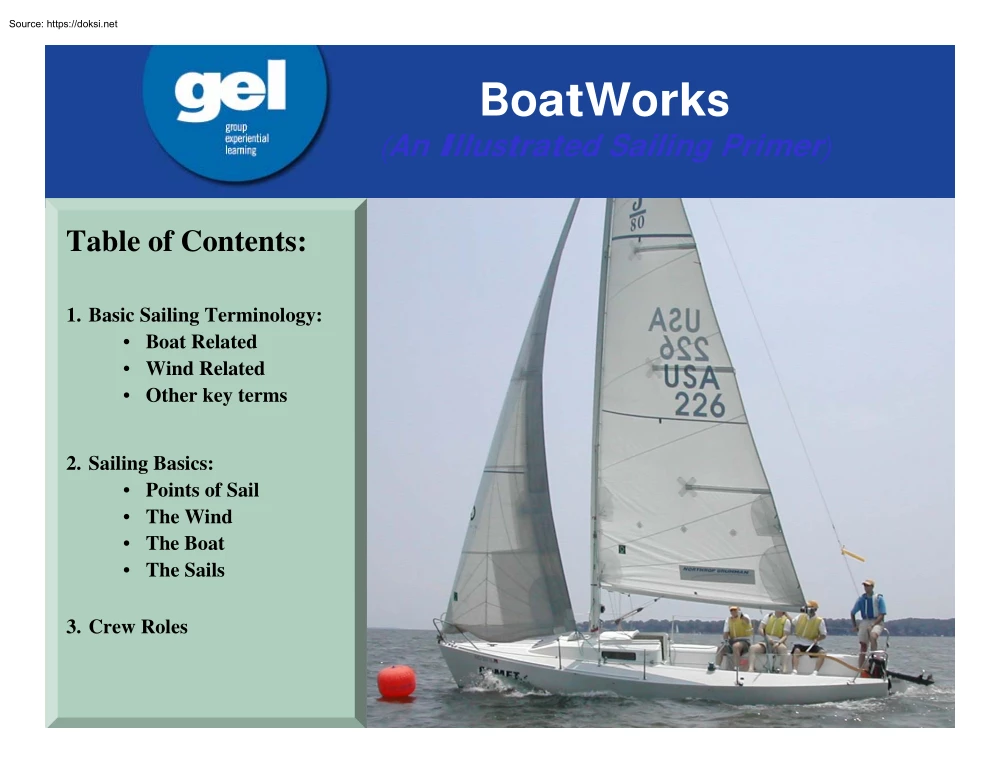A doksi online olvasásához kérlek jelentkezz be!

A doksi online olvasásához kérlek jelentkezz be!
Nincs még értékelés. Legyél Te az első!
Mit olvastak a többiek, ha ezzel végeztek?
Tartalmi kivonat
BoatWorks (An Illustrated Sailing Primer) Table of Contents: 1. Basic Sailing Terminology: • Boat Related • Wind Related • Other key terms 2. Sailing Basics: • Points of Sail • The Wind • The Boat • The Sails 3. Crew Roles Basic Sailing Terminology Bow –The front of the boat Mast Stern – The back of the boat Cockpit – The area of the boat that has seats/space for the crew to steer the boat and adjust the sails. Main or Mainsail Jib Mast – The vertical pole to which the sails and rigging are attached Boom – The horizontal pole to which the foot (bottom) of the mainsail is attached Main (mainsail) – The sail attached to the mast and the boom. This sail projects back from the mast toward the stern Jib – The sail forward of the mast. Usually attached to the bow of the boat and the mast. Boom Bow Stern Cockpit More Sailing Terminology Terms (wind related): Other terms: The diagram below identifies sailing terms that refer to locations on the
boat or the boat’s position in relation to the wind. The left side of the boat, while facing the bow is port The right side of the boat is called the starboard side. Leeward and windward are terms rwhich efer to the sides of the boat in relation to the wind. The side nearest the wind is the windward side, and the side which is away from the wind is the leeward side. Course – The direction the boat is being steered (heading) Falling off (bearing off, bearing away) – Altering the boat’s course to be further away from the direction of the wind (falling off or away from the wind) Jibing – Turning the stern of the boat through the wind so that the sails swing from one side of the boat to the other Heading up (coming up) - Altering the boat’s course to come closer to the direction of the wind Halyard – A line (rope) used to raise or lower a sail Bow Port Side Irons (“in irons”) – A condition in which the boat is pointing into the wind so that the sails cannot fill and
the boat significantly slows down or stops. Starboard Side Line – General term for any rope used on a boat Wind Luffing – When a sail starts to flutter and causes the boat to lose speed. This usually indicates that the sails, course of the boat or both needs adjustment to sail effectively. Points of Sail (see next page) – Points of Sail describe the angle between the boat’s course and the direction of the wind (often referred to as beating, reaching and running) Sheet – A line used to trim (pull in) or ease (let out) a sail Windward Side Leeward Side Stern Tacking – Turning the bow of the boat through the wind so that the sails swing from one side of the boat to the other Points of Sail (The WindThe Boat) Wind The points of sail relate to the angle between a sailboat's heading, or course, and the direction of the wind. There are three basic courses: • BEATING (wind is from the bow) • REACHING (wind is from the side) • RUNNING (wind is from the stern
(astern)) • Sails are trimmed in (pulled in) as you head closer to the wind (heading up) and eased out (let out) as you head further from the wind (falling off). • The diagram is symmetrical about the eye of the wind (dotted line). For example, there are two close reaches, one with the wind hitting the starboard side first (starboard tack), and one with the wind hitting the port side first port tack. BEATING (close hauled) (close hauled) No Sail Zone REACHING Notice two things: BEATING REACHING A sailboat can sail in any direction except into the wind. Specifically, there is a zone of about forty-five degrees on either side of the eye of the wind (ninety degrees altogether) in which the sails will not fill. This zone is called the No Go Zone and the boat will be “in irons”. Into the Wind (“in irons”) RUNNING Terms (wind related): Driver or Helmsman: Main Trimmer: • Responsible for steering the • Responsible for the main sail sailboat. • Key
contributor to speed & • Focus is on speed! maneuverability of the sailboat. Main • Must communicate & coordinate his/her actions with • Must coordinate actions with the Main & Jib Trimmer Jib Trimmer and Driver Crew Roles Jib Trimmer(s): Strategist: • Responsible for the Jib (sail) •responsible for communications • Contributes to speed & •assists team with navigation & maneuverability of the planning sailboat. •monitors the boat’s location, • crucial role when the sailboat progress & performance relative makes major course changes to the course and other boats Jib Coach
boat or the boat’s position in relation to the wind. The left side of the boat, while facing the bow is port The right side of the boat is called the starboard side. Leeward and windward are terms rwhich efer to the sides of the boat in relation to the wind. The side nearest the wind is the windward side, and the side which is away from the wind is the leeward side. Course – The direction the boat is being steered (heading) Falling off (bearing off, bearing away) – Altering the boat’s course to be further away from the direction of the wind (falling off or away from the wind) Jibing – Turning the stern of the boat through the wind so that the sails swing from one side of the boat to the other Heading up (coming up) - Altering the boat’s course to come closer to the direction of the wind Halyard – A line (rope) used to raise or lower a sail Bow Port Side Irons (“in irons”) – A condition in which the boat is pointing into the wind so that the sails cannot fill and
the boat significantly slows down or stops. Starboard Side Line – General term for any rope used on a boat Wind Luffing – When a sail starts to flutter and causes the boat to lose speed. This usually indicates that the sails, course of the boat or both needs adjustment to sail effectively. Points of Sail (see next page) – Points of Sail describe the angle between the boat’s course and the direction of the wind (often referred to as beating, reaching and running) Sheet – A line used to trim (pull in) or ease (let out) a sail Windward Side Leeward Side Stern Tacking – Turning the bow of the boat through the wind so that the sails swing from one side of the boat to the other Points of Sail (The WindThe Boat) Wind The points of sail relate to the angle between a sailboat's heading, or course, and the direction of the wind. There are three basic courses: • BEATING (wind is from the bow) • REACHING (wind is from the side) • RUNNING (wind is from the stern
(astern)) • Sails are trimmed in (pulled in) as you head closer to the wind (heading up) and eased out (let out) as you head further from the wind (falling off). • The diagram is symmetrical about the eye of the wind (dotted line). For example, there are two close reaches, one with the wind hitting the starboard side first (starboard tack), and one with the wind hitting the port side first port tack. BEATING (close hauled) (close hauled) No Sail Zone REACHING Notice two things: BEATING REACHING A sailboat can sail in any direction except into the wind. Specifically, there is a zone of about forty-five degrees on either side of the eye of the wind (ninety degrees altogether) in which the sails will not fill. This zone is called the No Go Zone and the boat will be “in irons”. Into the Wind (“in irons”) RUNNING Terms (wind related): Driver or Helmsman: Main Trimmer: • Responsible for steering the • Responsible for the main sail sailboat. • Key
contributor to speed & • Focus is on speed! maneuverability of the sailboat. Main • Must communicate & coordinate his/her actions with • Must coordinate actions with the Main & Jib Trimmer Jib Trimmer and Driver Crew Roles Jib Trimmer(s): Strategist: • Responsible for the Jib (sail) •responsible for communications • Contributes to speed & •assists team with navigation & maneuverability of the planning sailboat. •monitors the boat’s location, • crucial role when the sailboat progress & performance relative makes major course changes to the course and other boats Jib Coach




